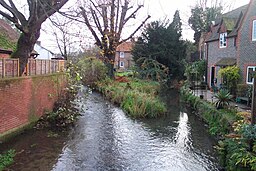River Pang
| Pang | |
| River | |
|
The River Pang in Pangbourne
|
|
| Country | England |
|---|---|
| Counties | Berkshire |
| Tributaries | |
| - left | River Bourne |
| Towns | Bradfield, Tidmarsh, Pangbourne |
| Source | |
| - location | Compton |
| Mouth | River Thames |
| - location | Pangbourne |
| Length | 23 km (14 mi) |
| Discharge | for Pangbourne |
| - average | 0.62 m3/s (22 cu ft/s) |
| - max | 6.50 m3/s (230 cu ft/s) 22 November 1974 |
| - min | 0.07 m3/s (2 cu ft/s) 24 August 1976 |
| Discharge elsewhere (average) | |
| - Frilsham | 0.21 m3/s (7 cu ft/s) |
The River Pang is a small chalk stream river in the west of the English county of Berkshire, and a tributary of the River Thames. It runs for approximately 23 kilometres (14 mi) from its source near the village of Compton to its confluence with the Thames in the village of Pangbourne.
The river, and its water voles, are thought to have inspired author Kenneth Grahame's character Ratty and his book The Wind in the Willows.
The river's source is normally near the village of Compton, although the exact location varies depending on rainfall levels. In times of high rainfall it can be traced back to Farnborough, some four miles to the north-west, whilst at other times it may be as far downstream as Hampstead Norreys.
In the village of Compton the Pang is joined by the River Roden, a similar but smaller chalk stream with its source on Roden Downs to the north east of the village. At first it flows south from Compton through the villages of Hampstead Norreys and Frilsham, before turning east to flow through the villages of Bucklebury, Stanford Dingley and Bradfield.
To the east of Bradfield the Pang is joined by the River Bourne and turns north to flow through the villages of Tidmarsh and Pangbourne, eventually entering the Thames between Whitchurch Lock and Whitchurch Bridge.
...
Wikipedia

